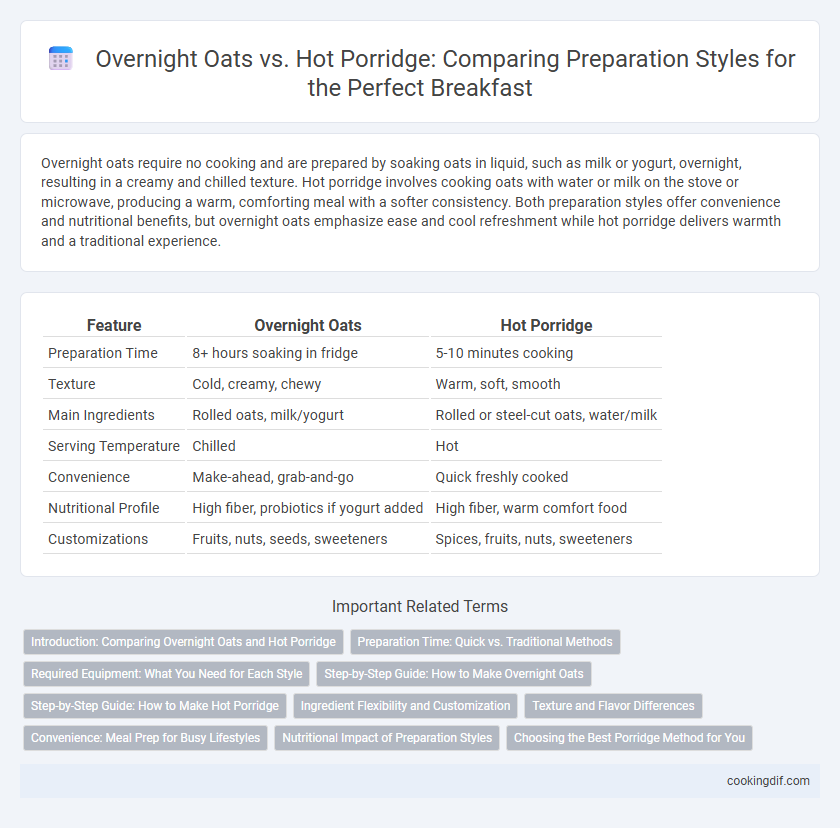Overnight oats require no cooking and are prepared by soaking oats in liquid, such as milk or yogurt, overnight, resulting in a creamy and chilled texture. Hot porridge involves cooking oats with water or milk on the stove or microwave, producing a warm, comforting meal with a softer consistency. Both preparation styles offer convenience and nutritional benefits, but overnight oats emphasize ease and cool refreshment while hot porridge delivers warmth and a traditional experience.
Table of Comparison
| Feature | Overnight Oats | Hot Porridge |
|---|---|---|
| Preparation Time | 8+ hours soaking in fridge | 5-10 minutes cooking |
| Texture | Cold, creamy, chewy | Warm, soft, smooth |
| Main Ingredients | Rolled oats, milk/yogurt | Rolled or steel-cut oats, water/milk |
| Serving Temperature | Chilled | Hot |
| Convenience | Make-ahead, grab-and-go | Quick freshly cooked |
| Nutritional Profile | High fiber, probiotics if yogurt added | High fiber, warm comfort food |
| Customizations | Fruits, nuts, seeds, sweeteners | Spices, fruits, nuts, sweeteners |
Introduction: Comparing Overnight Oats and Hot Porridge
Overnight oats require no cooking and are prepared by soaking rolled oats in liquid, such as milk or yogurt, overnight, resulting in a creamy, cold texture. Hot porridge involves boiling oats in water or milk, producing a warm, soft consistency with a traditional taste. Nutritionally, both methods offer high fiber and complex carbohydrates, but overnight oats retain more of their natural enzymes due to the lack of heat.
Preparation Time: Quick vs. Traditional Methods
Overnight oats require minimal morning preparation, as oats soak in liquid for several hours or overnight, offering a quick and convenient option with ready-to-eat texture. Hot porridge follows a traditional cooking method involving stovetop or microwave heating, usually taking 5 to 10 minutes to prepare, which can be longer but yields a warm, comforting meal. Preparation time efficiency makes overnight oats favorable for busy mornings, while hot porridge suits those who prefer freshly cooked, warm dishes.
Required Equipment: What You Need for Each Style
Overnight oats require minimal equipment, primarily a mason jar or airtight container for soaking the oats in the refrigerator. Hot porridge preparation demands a stove or microwave-safe pot and a heat source to cook the oats thoroughly, along with a spoon for stirring. Both styles benefit from measuring cups for precise ingredient portions, but hot porridge often requires more utensils due to the cooking process.
Step-by-Step Guide: How to Make Overnight Oats
Overnight oats require mixing rolled oats with liquid such as milk or yogurt, then refrigerating the mixture for at least 6 hours to allow absorption and softening. Unlike hot porridge cooked on a stove or microwave, overnight oats are prepared without heat, preserving cold texture and nutrients. To make overnight oats, combine 1/2 cup oats with 1/2 cup milk, stir in sweeteners or toppings, cover, and refrigerate overnight for a quick, nutrient-dense breakfast.
Step-by-Step Guide: How to Make Hot Porridge
To make hot porridge, start by combining rolled oats with water or milk in a saucepan over medium heat. Stir continuously for about 5 to 7 minutes until the mixture thickens and reaches a creamy consistency. Finish by adding toppings like fresh fruit, nuts, or honey for enhanced flavor and texture.
Ingredient Flexibility and Customization
Overnight oats offer exceptional ingredient flexibility, allowing for a diverse range of add-ins such as fruits, nuts, seeds, and flavorings to be mixed directly into the oats before soaking. Hot porridge provides real-time customization opportunities, enabling adjustments to texture, sweetness, and spice levels during cooking. Both preparation styles cater to personalized dietary preferences, but overnight oats excel in convenience and nutrient retention from raw ingredients.
Texture and Flavor Differences
Overnight oats offer a creamy, cold texture with a mild, natural sweetness due to prolonged soaking, preserving the subtle flavors of raw oats and added ingredients like fruits or nuts. Hot porridge delivers a warm, smooth, and velvety consistency enhanced by cooking, which intensifies the oats' nuttiness and allows spices like cinnamon or nutmeg to infuse fully. Texture-wise, overnight oats remain thicker and more chewy, while hot porridge is softer and more blendable, catering to different sensory preferences.
Convenience: Meal Prep for Busy Lifestyles
Overnight oats offer unmatched convenience for busy lifestyles by allowing meal prep in advance, requiring minimal morning effort and no cooking time. Hot porridge demands active preparation each morning, including cooking and stirring, which can be time-consuming during rushed schedules. The grab-and-go nature of overnight oats makes them ideal for those seeking quick, nutritious breakfast options without compromising on taste or texture.
Nutritional Impact of Preparation Styles
Overnight oats retain more heat-sensitive nutrients like vitamin C and certain antioxidants due to the absence of cooking, while hot porridge enhances starch digestibility and increases bioavailability of minerals such as iron and calcium. The soaking process in overnight oats also promotes the breakdown of phytic acid, improving mineral absorption, whereas the heat in hot porridge can reduce enzyme inhibitors that may affect digestion. Both preparation methods offer distinct nutritional benefits depending on bioactive compounds targeted and individual dietary needs.
Choosing the Best Porridge Method for You
Overnight oats offer a quick, no-cook option by soaking rolled oats in milk or yogurt, preserving nutrients and creating a creamy texture ideal for busy mornings. Hot porridge, traditionally made by simmering oats in water or milk, provides a warm, comforting meal with enhanced flavor through caramelization during cooking. Choosing between overnight oats and hot porridge depends on your time availability, texture preference, and whether you prioritize a cold, ready-to-eat dish or a warm, freshly prepared breakfast.
Overnight oats vs Hot porridge for preparation style Infographic

 cookingdif.com
cookingdif.com